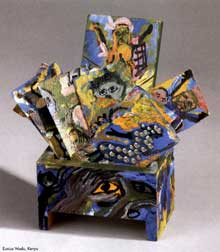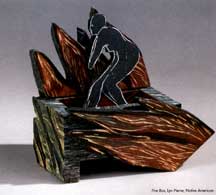
Just to set things straight, Pandora was the Athenian name for the Earth Goddess Rhea. The nasty little tale in which Hesoid, the Greek historian, blamed all the world’s follies and ills on a woman who opened up a box of Spites is “not a genuine myth but an anti-feminist fable, probably of his own invention” according to mythographer Robert Graves. “Pandora’s jar originally contained winged souls.”
Well, the real Pandora is back in action. Because of an idea that began right here in Santa Barbara, two hundred women will be sending their “winged souls” out into the world, contained in tiny wooden boxes. The exhibit, WOMEN/BEYOND BORDERS premieres at Santa Barbara’s Contemporary Art Forum November 4, 1995 and will travel to twenty countries ending up in Washington DC. in the year 2000 when a permanent home will be sought for the collection. “The care and work that went into transforming simple, inexpensive boxes into objects that are compelling and affecting must be seen to be believed.” comments Nancy Doll, CAF’s Director.
The homespun project that involves so many women artists began over three years ago when Santa Barbarans Elena Siff and Lorraine Serena played with the notion of a traveling women’s art show. “But the shipping costs alone would be impossible...unless what we made was tiny,” recalls practical-minded Elena. They grafted this fact onto an absurdly hopeful idea - women connecting with one another on a global level. With no format or venue, they proceeded through word of mouth to gather a small group of artists. The hardest part, which required more than a year of brainstorming, was coming up with the right vehicle for this concept.
A good idea can be right in front of you, and in this case it was right on the table. During an evening meeting someone noticed a little wood box stuffed with candies. “That’s it - a box!” And the project took wing. A practical size to ship, intimate, yet metaphorically expansive. The project began to define itself. Using the souvenir box as a prototype, Lorraine had 3 1/2” x 2” x 2 1/2” pine boxes made and distributed them to a group of Santa Barbara women artists. Several months later Isabel Barbuzza, Ciel Bergman, Sky Bergman, Rose Bilat, Beverly Decker, Elisse Pogofsky-Harris, Alice Hutchins, Evelyn Jacob-Jaffe, Saritha Margon, Lorraine Serena, Elena Siff, Maria Velasco, Victoria Vesna and I placed our box-assemblages on the table. Our art forms range from sculpture, installations, painting and writing, to weaving on the world wide web. Though we usually work alone, this project gave us the opportunity to be part of a unique network.
With an elfin industriousness we assembled information sheets, rubber-banded to two hundred boxes that we hand-glued together, and pooled our contacts in other countries. It was a little like quilting, where each person makes a piece that will eventually become part of a whole. The group fell into a working rhythm quite naturally, though Serena has been the mainstay of the project. “Building community is my artform,” she reasons, as she spends hours at the computer disseminating information, and assembling the necessary materials we’ve gathered in order to seek funding sources and confirm venues for the multi-sited exhibition.

Our hands-on process involved family members and friends. Our selection of countries was made simply on the basis that someone in the group knew someone else abroad. Maria Velasco contacted fellow artists and a curator in Madrid. Isabel Barbuzza enlisted the help of her thirteen year old son, Xavier, who hand-delivered plain boxes to Eliana Molinelli, a former art professor in Argentina. Eliana distributed the boxes to selected women artists. Elena Siff’s daughter Ravelle, a UCLA student studying abroad at Hebrew University in Israel received a letter from mom; “ You have an assignment. Find me an Israeli curator.” And she did. Daphna Naor represents several women artists from her home-based gallery in Jerusalem. She arranged for two exhibits in Jerusalem coinciding with an International Women’s Day celebration to be held there in 1996. “Women/Beyond Borders could be a start of international communication ...new ideas can emerge between the artists as a result of having open channels in a vital network.,” began her fax about scheduling. A friend of Elise Pogofsky-Harris hand-delivered boxes to Cubana women and Elise traveled to Italy to find an exhibition space in Tuscany. Beverly Decker arranged for a group of Native American women to represent their country within this country. Mari Olguin, visiting from Oaxaca, left my home with an information packet slipped in her suitcase and a week later we received a fax from Casa de Mujer’s (Women’s House) Director, Tanya Coen that opens, “we seem to have hit a small gold mine of Oaxacan women artists - send boxes ASAP!”
Santa Barbaran’s much coveted mañana-Zen lifestyle lends itself to a wild romanticism that allows one to dream. “This idea started out of frustration - feeling disconnected to a larger art world” Elena recalls, “but once we decided to have a group show, why limit it to a larger city - why not make it worldwide? If I had been living in L.A. I might never have gotten involved in this crazed notion.” Now, boxes and accompanying letters are arriving. They describe clusters of resultant spin-off activities in such places as Austria, Spain, Japan, Finland, and Italy. Within each country, Women/Beyond Borders has served as a catalyst for bringing artists together, perhaps because of the utter simplicity and unrestricted quality of our proposal.
Most cultures have a tradition of working collectively, lending a hand. Native and pioneer Americans built kivas, raised barns, shared talk and talent in quilting, beading or basket making circles. It seems that the more self-sufficient we became the lonelier the act of making things became as well. Today many women are seeking ways to meet informally or collaborate on group projects as a step toward undoing the isolation of solitary work. This is a timely project that has netted an imagination beyond borders.
What’s in a box? Gifts are wrapped in boxes. A box’s exterior adornment may belie a troubled interior, or a treasure chest of memories, an inner world, a womb or a tomb. Is it an image of entrapment or seclusion or simply an empty stand used as a pedestal? The computer too is a box, through which thousands of messages are being transmitted worldwide to chart the progress of Women/Beyond Borders. UCSB professor Victoria Vesna, one of the participating artists has facilitated this aspect, aptly dubbed “f-e-mail and beyond”.

The boxes started coming. We had no idea what to expect. Initially we had discussed themes for a group exhibition such as “self-portrait” or “women’s spirituality”, but this seemed like hyperbole. We wanted to be surprised by the unlegislated nature of the idea. We feared that any affiliation with Embassy programs or Museum Boards might impose a tangle of guidelines that would sap the energy from this grassroots endeavor. For centuries, women have communicated vital information to one another while attending to mundane domestic tasks. Word of mouth, folded into a larger conversation, is a hotline that simply works. We added the tools of modern communication technology to this age-old tradition, tailoring both styles to suit our needs for a rapid yet personal format.
One day Lorraine received an unexpected phone call. “Hi, I’m Joni Waite from Nairobi. I’m at the Carpinteria Greyhound bus stop, can you come collect me?” Even though she was exhausted Joni could barely contain herself as she pulled eleven transformed boxes from among wads of newspaper, “In Kenya women have been subjugated for years as chattels, but recently many have begun finding a voice...”. In the midst of helping Joni unwrap the boxes Lorraine was hit with a profound sense of the project’s importance. “Because of Women/Beyond Borders The National Gallery in Kenya has agreed to a first, an all woman show. These little boxes brought us together,” said Waite.
“Let things fall into place. This project has a life of its own,” advised Liz Brown, Curator of Twentieth Century art at the University Art Museum at UCSB. “That’s the beauty of it.”
The spirit of cooperation integral to this undertaking cuts across cultural, religious and economic boundaries. Whether grouped thematically or clustered according to ways in which each artist draws from her countries’ cultural traditions, each box is a distinct portrait.
Several of the boxes use traditional motifs or materials. Many of the Mexicana boxes are ornate reliquaries, encrusted with pigment, gold, and memorabilia. The Argentinas deconstructed their boxes to create sculptural balancing acts. The Parisian pieces are sleek and abstract. African women carved the box surfaces. The crouched body of a woman softens the hard edges of one box, within which sleeps a small infant. The Israeli group (including one Arab woman), use metal, concrete and wire - heavy visual interpretations of the trappings of endless conflict, linked with written messages stressing reflection and reconciliation.
The increased responsibility to effectively manage a project that has mushroomed has, of course, launched us into a new phase. Women/Beyond Borders is now actively seeking volunteer help as well as private and corporate sponsorship to cover expenses for a full color catalogue, video documentation, a directory of participating artists, galleries and museums, and shipping costs. The word is out and a party line of women across the globe is open.
Individually, and as a whole, Women/Beyond Borders is a visual anthology, a vivid tableaux of lives lived in community, fascinatingly diverse, slightly irreverent, confident and distinct. The warp of common themes and the woof of individual expression has created a fabric of the highest quality.
A map of the world hangs in Lorraine Serena’s studio, our usual meeting place. Red pushpins speckle the map, identifying participating countries. One or two exhibition spaces, a dozen women artists, adjunct workshops, discussion groups, and a complex web of fax, Internet and written communiqués dance on the head of each pin.
copyright Mary Heebner
for Santa Barbara Magaziine Fall 1995


